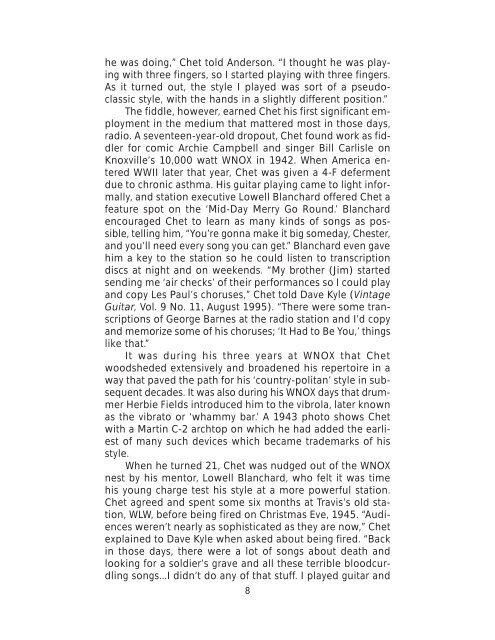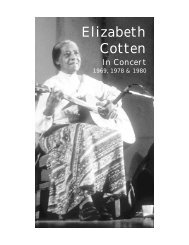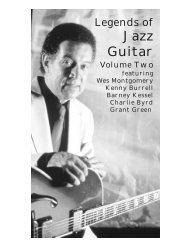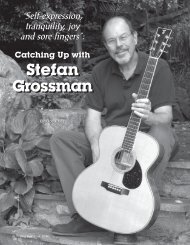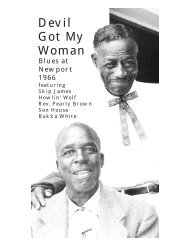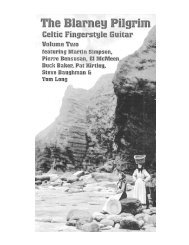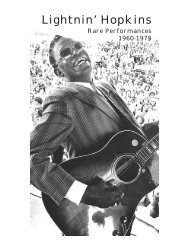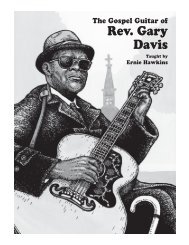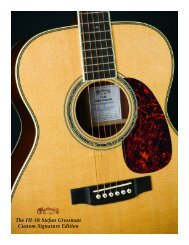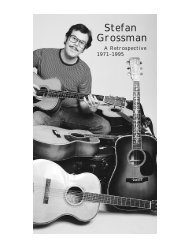Chet Atkins Chet Atkins - Stefan Grossman's Guitar Workshop
Chet Atkins Chet Atkins - Stefan Grossman's Guitar Workshop
Chet Atkins Chet Atkins - Stefan Grossman's Guitar Workshop
You also want an ePaper? Increase the reach of your titles
YUMPU automatically turns print PDFs into web optimized ePapers that Google loves.
he was doing,” <strong>Chet</strong> told Anderson. “I thought he was playingwith three fingers, so I started playing with three fingers.As it turned out, the style I played was sort of a pseudoclassicstyle, with the hands in a slightly different position.”The fiddle, however, earned <strong>Chet</strong> his first significant employmentin the medium that mattered most in those days,radio. A seventeen-year-old dropout, <strong>Chet</strong> found work as fiddlerfor comic Archie Campbell and singer Bill Carlisle onKnoxville’s 10,000 watt WNOX in 1942. When America enteredWWII later that year, <strong>Chet</strong> was given a 4-F defermentdue to chronic asthma. His guitar playing came to light informally,and station executive Lowell Blanchard offered <strong>Chet</strong> afeature spot on the ‘Mid-Day Merry Go Round.’ Blanchardencouraged <strong>Chet</strong> to learn as many kinds of songs as possible,telling him, “You’re gonna make it big someday, Chester,and you’ll need every song you can get.” Blanchard even gavehim a key to the station so he could listen to transcriptiondiscs at night and on weekends. “My brother (Jim) startedsending me ‘air checks’ of their performances so I could playand copy Les Paul’s choruses,” <strong>Chet</strong> told Dave Kyle (Vintage<strong>Guitar</strong>, Vol. 9 No. 11, August 1995). “There were some transcriptionsof George Barnes at the radio station and I’d copyand memorize some of his choruses; ‘It Had to Be You,’ thingslike that.”It was during his three years at WNOX that <strong>Chet</strong>woodsheded extensively and broadened his repertoire in away that paved the path for his ‘country-politan’ style in subsequentdecades. It was also during his WNOX days that drummerHerbie Fields introduced him to the vibrola, later knownas the vibrato or ‘whammy bar.’ A 1943 photo shows <strong>Chet</strong>with a Martin C-2 archtop on which he had added the earliestof many such devices which became trademarks of hisstyle.When he turned 21, <strong>Chet</strong> was nudged out of the WNOXnest by his mentor, Lowell Blanchard, who felt it was timehis young charge test his style at a more powerful station.<strong>Chet</strong> agreed and spent some six months at Travis’s old station,WLW, before being fired on Christmas Eve, 1945. “Audiencesweren’t nearly as sophisticated as they are now,” <strong>Chet</strong>explained to Dave Kyle when asked about being fired. “Backin those days, there were a lot of songs about death andlooking for a soldier’s grave and all these terrible bloodcurdlingsongs...I didn’t do any of that stuff. I played guitar and8


